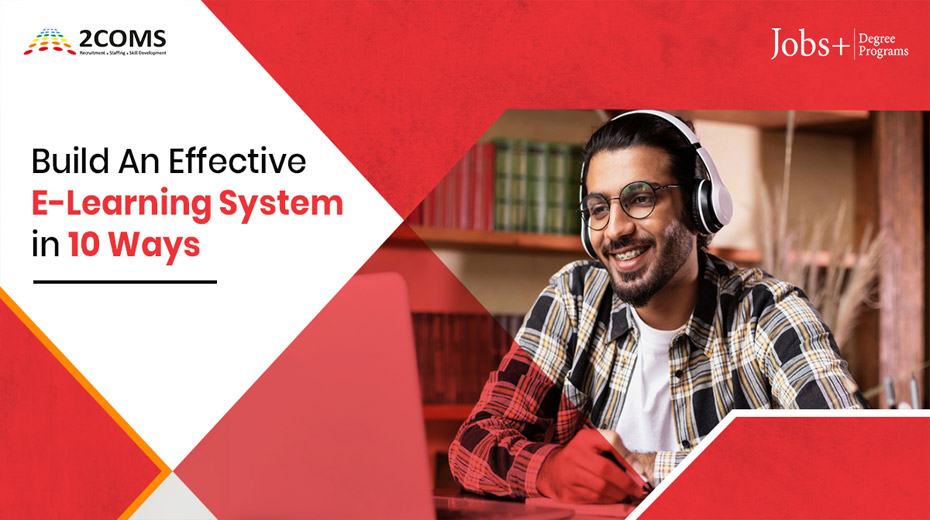Build An Effective E-Learning System in 10 Ways
Online learning has created new opportunities in education. Nevertheless, as it becomes more effective, it improves. So, here are the top-10 ways to make e-learning more effective.
Build An Effective E-Learning System in 10 Ways
E-learning is taking the world of education on a roller-coaster ride. Gone are the days when students traveled to their schools, colleges, or universities to learn. Instead, the internet has improved learning opportunities.
The concept of online learning has also had a significant impact on India. There are no more "gurukuls" or an emphasis on rote memorization. Instead, influenced by Mahatma Gandi's definition of education—"an all-around drawing of the best in a child and man in body, mind, and spirit"—our education sector is working tirelessly to emphasize the overall growth and development of students. And emerging trends in the e-learning system make it easier to provide students with a well-rounded learning experience.
The union cabinet has allocated Rs 1043 billion for the education industry. This has laid the groundwork for the digital impetus. But, how can e-learning be made more effective? This post is about how to make virtual learning impactful.
Understanding E-Learning or Online Learning
E-learning is a system in which learning takes place on virtual platforms. It is a formal learning system that makes use of electronic information resources. Online learning is a modernized version of distance learning in which virtual platforms enable students to learn while sitting in the comfort of their homes.
Although we now see widespread adoption and implementation of virtual learning, the scene was not the same even a decade ago. Then, online education was not universally welcomed. The stated reason was that this system lacked the critical human component. However, the situation has drastically changed, and the audience has embraced this new learning system. Not only that, but we are now working to improve the online learning scenario so that it is available in every corner of the country.
Benefits of Online Learning
The online course format can help you prosper both academically and professionally. Here are the top 5 advantages of online learning for students.
● Flexibility
One of the most significant advantages of online learning is increased flexibility. You can do your lessons from any location. There is no longer any need to travel to a classroom to learn.
● Multiple Choices
The flexibility is focused on how you undertake lessons and the courses you select. Everything from degree programs to career certificate programs and everything in between is available.
● Technical Know hows
Your online degree also translates into strong technical abilities. You will probably use virtual learning materials and become acquainted with new software applications as part of your curriculum. This will help you improve your technical skills and knowledge.
● Low Cost of Education
Online degrees and diplomas are frequently less expensive than traditional (offline) courses. Although the tuition fee may not be significantly reduced, other expenses such as travel, textbook, and so on can be avoided.
● Upskilling
Learning online is a great way to upskilling or reskilling. There is a growing demand for job-ready candidates who are up to date on the latest digital trends. Virtual platforms provide a variety of courses that help learners become job-ready. In-demand courses such as digital marketing, retail management, and so on are easily accessible. Additionally, one can pursue online courses besides their job, which is a distinct advantage.
Making E-Learning Effective: 10 Impressive Ways
Without a doubt, e-learning is the future of education in India. However, to help it reach its pinnacle, we must work to make it more effective or impactful. So, here are the top ten ways that online education can have a significant impact.
1. The Story Arc Model
Weaving stories around boring lessons is one of the best ways to make them exciting and immersive. A story-based learning system can pave the way for more engaging lessons. Freytag's Pyramid model is a five-stage simulation based on dramatic storytelling.
- ● Inciting Incident or introduction
- ● Rising action
- ● Climax
- ● Falling action
- ● Catastrophe
It is structured similarly to a full-fledged story and has been followed since Aristotle's Poetics, with exposition leading to resolution. This model keeps learners' attention by attenuating their interests as they progress through their lessons.
2. Go Social
When we learn in a social setting, we learn more effectively. Besides, CIPD 2020 has reported that the social learning system has gained significant traction as a content delivery method. It would undoubtedly be tedious to continue learning in isolation. After all, we are social beings who enjoy collaborating and interacting with others. So why not include social learning in your e-learning system?
Introducing webinars, discussion forums, and conferences, among other things, could help make the learning process more engaging. In addition, longer lessons can be broken down into short clips and posted as YouTube videos so that students can access them whenever they want. Lesson snippets can also be posted on social media sites to break up the content.
3. Get Visuals
Incorporating visual aids into lessons is not a novel concept. However, we learn more effectively when we visualize things. And thanks to the internet, it is much easier to incorporate images, videos, charts, maps, and other visuals into online lessons. We can also use comic strips to make online learning more interactive and memorable.
The trick to using visuals in virtual learning is to make the entire learning environment less formal, fun, and engaging. Furthermore, images and videos aid in the breakdown of complex lessons into simpler versions.
4. Encourage Active Participation
Because we do not all meet under one roof in a remote education setting, it is critical to make lessons interactive to keep learners engaged. In other words, encourage learners' active participation to make e-learning more effective and successful. This is especially important when adult learners are involved. They do not prefer rote learning or learning by simply reading the theoretical subject matter. Instead, adult learners enjoy learning by doing stuff for themselves.
As a result, providing opportunities for learners to investigate within the e-learning course would encourage their participation. Humans are curious creatures. And online educators must capitalize on this curiosity by designing lessons that require "pulling" information from their surroundings.
5. Make Learning Mobile Friendly
Online education cannot rely solely on computers or laptops. Making online apps where learners can log in and learn is critical. That way, learners will have greater flexibility in learning their preferred lessons anytime and from any location. The mantra is "go mobile!"
6. Incorporate Different Learning Styles
Not every learning style is appropriate for every learner. As a result, to make e-learning accessible to the general public, it is necessary to recognize different learning styles and design lessons accordingly. Some of the learning styles that can be incorporated into online learning platforms are listed below.
- ● Visual- images, workflow, charts, videos, etc.
- ● Verbal- quiz, Q&A sessions, discussion forums, etc.
- ● Audio- narrated videos, webinars, story letting, etc.
- ● Kinesthetic- provide 'in-field' assignments, give different website options to visit to gather data, etc.
7. Gamification
Learning gamification is a current e-learning trend. In India, it is still in the metaphase. However, there is a growing emphasis on incorporating it into e-lessons for Generation Z. Currently, gamification techniques for healthcare training are available through an MBA in hospital administration. Gradecraft and ClassCraft are two amazing apps that are currently being used on international platforms to gamify the entire lesson plan.
8. User-Friendly Interface
Providing a seamless online experience through a user-friendly interface is key to attracting more learners to e-learning. The presentation of online content should not be complicated. Consider making your Learning Management System (LMS) stylish while remaining simple and robust. Microlearning, a personalized dashboard, easy navigation, mobile or tablet learning, and other methods could be used to create a user-friendly online learning interface.
9. The Two-Way Communication
If there is open two-way communication, e-learning can be extremely effective. Make use of online meeting platforms. There are numerous options available, including Zoom, Skype, Google Meet, and Microsoft Teams, to name a few. Regular meetings and discussion sessions would prevent the lesson from becoming dull. It would also aid in keeping teachers and students on the same page.
10. Feedback
Because the virtual learning system is constantly evolving, it is critical to solicit student feedback. You might be surprised by creative suggestions. Furthermore, students will feel more important and more engaged with the course.
The Takeaway
So here are our thoughts on the top ten ways to make e-learning more effective. Of course, this is not an exhaustive list, and additional suggestions are always welcome. Click here to learn more about interactive online courses and how they can help you advance your career.































